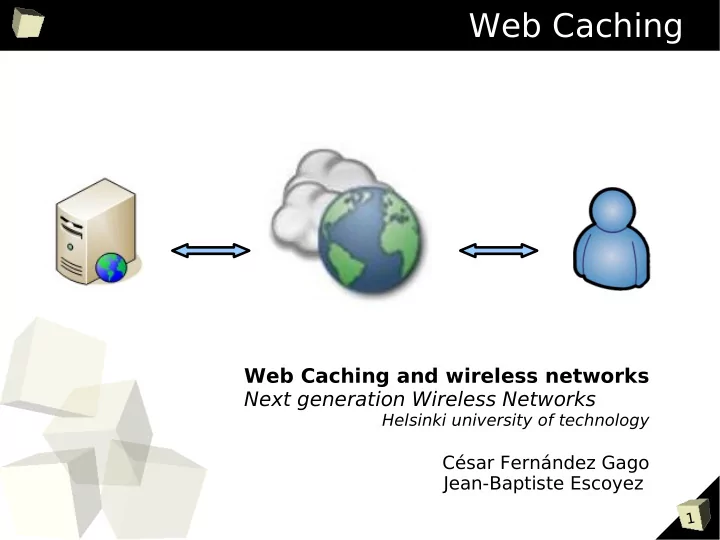

Web Caching Web Caching and wireless networks Next generation Wireless Networks Helsinki university of technology César Fernández Gago Jean-Baptiste Escoyez 1
Index ■ Web caching concepts ■ Web caching issues How does it works? Content delivery Cache consistency ➔ Wireless issues Cache cooperation ➔ Wireless issues 2
Introduction: Concepts ■ Web caching Different scheme: multiple readers, one writer Browser Cache & Proxy: ➔ Improve response time ➔ Save bandwidth ➔ Real-life usage: hierarchy, reverse ■ Other proxy services ➔ Security - Ensure security policies . Virus . Authentication & Billing (Wireless) 3
Http1.1: How does it work? ¿? Ø Cache miss Slow Hit conditional Fast Hit GET / HTTP/1.1 Host: www.google.fi Proxy-Connection: keep-alive Accept-Encoding: gzip,deflate 4
Http1.1: Optimizing a website ■ Expires ■ Cache-control header: max-age=[seconds] ➔ s-maxage=[seconds] HTTP/1.1 200 OK public Date: Fri, 30 Oct 2004 13:19:41 GMT Server: Apache/1.3.5 (Unix) no-cache Cache-Control: max-age=3600, must-revalidate Expires: Fri, 30 Oct 1998 14:19:41 GMT no-store Last-Modified: Mon, 29 Jun 2004 02:28:12 GMT ETag: "3e86-410-3596fbbd" must-revalidate Content-Length: 1040 Content-Type: text/html ➔ proxy-revalidate ■ Validators: Etag, last-modified.. 5
Content delivery ■ On demand request-response (Scales bad) ■ Prefetching Proxy caching = 26%, prefetching = 60% Different techniques: ➔ Dependency graph (learning patterns) ➔ Prediction scheme ➔ Server Volumes ■ Multicast push Asynchronous multicast push (AMP) Continuous multicast push (CMP) Geographic push caching ■ Optimizations: send only “differences” 6
Cache Consistency : Problem ■ Multiple copies of objects created How and when renewing the copies? ■ Goals Avoid stale copies Keep non useful traffic as low as possible Sub-domain Internet Client Proxy Server 7
Cache Consistency : Polling ■ Solution 1: Polling every time request poll doc1.html (vx) doc1.html doc1.html (v*) copy returned retrieve if stale Sub-domain Internet Client Proxy Server ■ Benefits : Strong cache consistency ■ Drawbacks : Cache hits are always slow 8
Cache Consistency : Polling ■ Solution 2 : (Widely employed) Assign a TTL to each document poll if TTL expired request doc1.html doc1.html (vx) doc1.html (v*) copy returned retrieve and reset TTL if stale increase TTL if up-to-date Sub-domain Internet Client Proxy Server ■ Benefits : More fast hits ■ Drawbacks : Weak cache consistency (5% stale) Can lead to problems (e.g. Weather forecast) 9
Cache Consistency : Invalidation ■ Solution 3 : The server helps the proxy in maintaining consistency Invalidation protocols ➔ When the proxy makes a request, - Piggyback cache validation (PCV) : the proxy provides some other potentially stale copies for server validating - Piggyback cache invalidation (PCI) : the server provides some copies which have been updates since last access . Use of volumes - Volume lease : . The client receive a lease from the server . During the lease validity the client can retreive copies from proxy . When the lease expire the client has to renew it 0 1
Cache Cooperation ■ Idea Makes the proxies cooperating ➔ To improve the access latency ➔ To reduce the traffic load ■ Different techniques Hierarchical caching ➔ Manually configured Intercache communication ➔ Protocols to share data ➔ Use of volumes Transparent caching ➔ Router redirect traffic to the proxy 1 1
The wireless problem ■ Wireless networks: Save bandwidth, Low power, Client disconnections Location dependent information services Movements ➔ Temporal dependent updates ➔ Location dependent updates 2 1
The wireless problem: Cache invalidation ■ Update propagation ■ Update invalidation ■ Stateful-based protocols Keeping track of each client ■ Stateless-based protocols asynchronous ➔ If disconnected ? synchronous (periodic) ➔ Waiting for a long time 3 1
The wireless problem : Cache invalidation ■ Cache invalidation Bit vector with compression (BVC) Grouped bit vector with compression (GBVC) Implicit scope information (ISI) ■ Caching routes On demand routing protocol (Dynamic Source route protocol) 4 1
The Wireless Problem: Cache cooperation ■ Classical cooperation scheme no valid anymore Hierarchical cache : too different Distributed cache : too complexe, heavy ■ Cooperative caching scheme Cache line: ID, Tag, State bytes, Link fields, Client list and Origine 5 1
Conclusion ■ Cache technologies for wireless networks are not mature yet ■ The possible improvements are not very significant ■ Not a lot of common data to share Caching issues only have sense in location dependency problems The wireless schemes are very different of the classical schemes ■ Caching on fixed hosts links is not influenced by wireless networks problems 6 1
Questions? Questions? 7 1
References ➔ Performance Analysis of Location-Dependent Cache Invalidation Schemes for Mobile Environments Jianliang Xu, Member, IEEE, Xueyan Tang, and Dik Lun Lee, March 03 ➔ Caching Strategies in On-Demand Routing Protocols for Wireless Ad Hoc Networks, Yih-Chun Hu, David B. Johnson, Carnegie Mellon University ➔ Cache invalidation scheme for mobile computing systems with real-time data, CM SIGMOD Record archive, Volume 29 , Issue 4 (December 2000) ➔ Network Cache Model for Wireless Proxy Caching James Z., Wang Zhidian, Du Pradip, K Srimani, Department of Computer Science, Clemson University 8 1
Recommend
More recommend